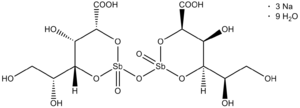- Sodium stibogluconate
-
Sodium stibogluconate 
Systematic (IUPAC) name 2,4:2',4'-O-(oxydistibylidyne)bis[D-gluconic acid] Clinical data AHFS/Drugs.com International Drug Names Pregnancy cat. ? Legal status POM (UK) Routes IV only Identifiers CAS number 16037-91-5 
ATC code P01CB02 QP51AB02 PubChem CID 16685683 DrugBank DB05630 ChemSpider 21106382 
UNII V083S0159D 
KEGG D00582 
ChEMBL CHEMBL367144 
Chemical data Formula C2H38Na3O26 Mol. mass 910.9 SMILES eMolecules & PubChem  (what is this?) stibogluconate (verify)
(what is this?) stibogluconate (verify)Sodium stibogluconate is a medicine used to treat leishmaniasis and is only available for administration by injection. It belongs to the class of medicines known as the pentavalent antimonials. Sodium stibogluconate is sold in the United Kingdom as Pentostam (manufactured by GlaxoSmithKline). Widespread resistance has limited the utility of sodium stibogluconate, and in many parts of the world, amphotericin or miltefosine is used instead.
Dosing
Sodium stibogluconate is available in the United Kingdom as Pentostam, which comes in 100 ml multi-dose glass bottles manufactured by GlaxoSmithKline. It can be diluted with 5% dextrose if necessary for ease of administration. It is available in the United States on a named-patient basis from the Centers for Disease Control and Prevention (CDC).
The dose of sodium stibogluconate is 20 mg/kg per day given by slow intravenous infusion (at least five minutes with cardiac monitoring). The injection should be stopped if there is coughing or central chest pain. The chemotherapeutic index was established by Leonard Goodwin during the Second World War when a treatment was urgently required for Allied troops during the invasion of Sicily.[1]
The maximum licensed dose is 850 mg per day, but most authorities now agree that there should be no maximum.[2]
The duration of treatment is usually 10 to 21 days and depends on the species of Leishmania and the type of infection (cutaneous or visceral). The advice of a specialist should always be sought.
Side effects
Sodium stibogluconate is exceedingly phlebotoxic. One of the practical problems is that after a few doses it can become exceedingly difficult to find a vein in which to inject the drug. The insertion of a PICC does not prevent the problem and can instead make it worse: the entire vein along the course of the PICC line can become inflamed and thrombose. The most practical way of administering a large dose of sodium stibogluconate is to dilute it in a large amount of fluid which then runs through over half an hour or so.
Pancreatitis is a common problem and the serum amylase or lipase should be monitored twice weekly; there is no need to stop treatment if the amylase remains less than four times the upper limit of normal; if the amylase rises above the cut-off then treatment should be interrupted until the amylase falls to less than twice the upper limit of normal, whereupon treatment can be resumed. Cardiac conduction disturbances are less common, but ECG monitoring while the medicine is injected is advisable and changes quickly reverse after the drug is stopped or the infusion rate is decreased.
The drug can be given intramuscularly but is exceedingly painful when given by this route. It can also be given intralesionally when treating cutaneous leishmaniasis (i.e., injected directly into the area of infected skin) and again, this is exceedingly painful and does not give results superior to intravenous administration.
Sodium stibogluconate can also cause a reduced appetite, metallic taste in mouth, nausea, vomiting, diarrhoea, headache, tiredness, joint pains, muscle aches, dizziness, and anaphylaxis.
References
- ^ "Leonard Goodwin - Telegraph". The Daily Telegraph. 14 January 2009. http://www.telegraph.co.uk/news/obituaries/4241645/Leonard-Goodwin.html. Retrieved 2009-01-18.
- ^ Murray HW, Berman JD, Davies CR, Saravia NG (2005). "Advances in leishmaniasis". Lancet 366 (9496): 1561–77. doi:10.1016/S0140-6736(05)67629-5. PMID 16257344. http://www.thelancet.com/journals/lancet/article/PIIS0140673605676295/fulltext.
- British National Formulary
- The Merck Index, 12th Edition. 742
Antiparasitics – antiprotozoal agents – Excavata antiparasitics (P01) Discicristata TrypanosomiasisAfrican trypanosomiasis: ornithine (Eflornithine#) • arsenical (Melarsoprol#) • benzamidine (Pentamidine#) • naphthalenesulfonate (Suramin#)
Chagas disease: nitroimidazole (Benznidazole#) • nitrofuran (Nifurtimox#)Pentavalent antimonials (Meglumine antimoniate#, Sodium stibogluconate)
benzamidine (Pentamidine#) • phosphorylcholine (Miltefosine) • neomycin (Paromomycin)Trichozoa nitroimidazole (Metronidazole#, Tinidazole) • benzimidazole (Albendazole)
thiazole (Nitazoxanide) • nitrofuran (Furazolidone)
aminoacridine (Quinacrine)Trichomoniasisnitroimidazole (Metronidazole, Secnidazole)
oxyquinoline (Iodoquinol) • tetracycline (Doxycycline) • neomycin (Paromomycin)Categories:- Orphan drugs
- Antiprotozoal agents
- World Health Organization essential medicines
- Antimony heterocycles
Wikimedia Foundation. 2010.
